Dell XPS 15 L502x: Now with Sandy Bridge
by Jarred Walton on April 20, 2011 1:10 AM ESTStill Lovin’ the 1080p Upgrade
The XPS 15 L501x garnered our Gold Editors’ Choice award largely on the merits of the upgraded 1080p LCD. Without a beautiful display, it would probably rate as a Bronze award at best. Six months later, at least on the LCD side nothing noteworthy has changed. Dell is still using an AU Optronics B156HW1 panel, and performance is roughly the same as before. There’s a certain amount of variance among LCD panels, and the L501x actually comes out slightly ahead in the tests, but you’re not liable to see the difference with the naked eye.
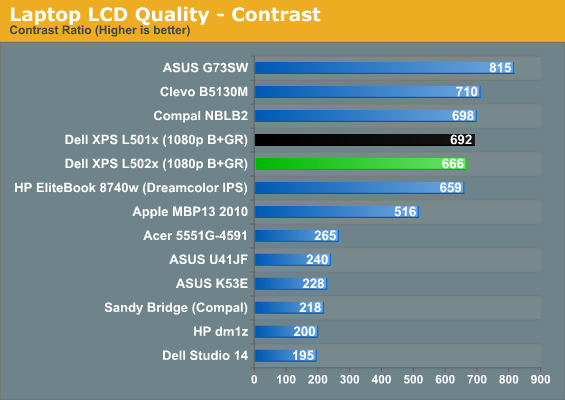
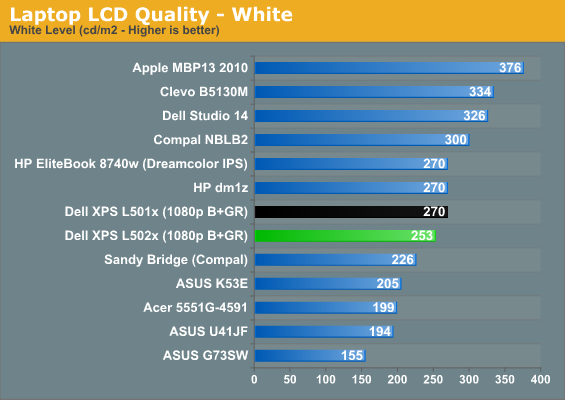

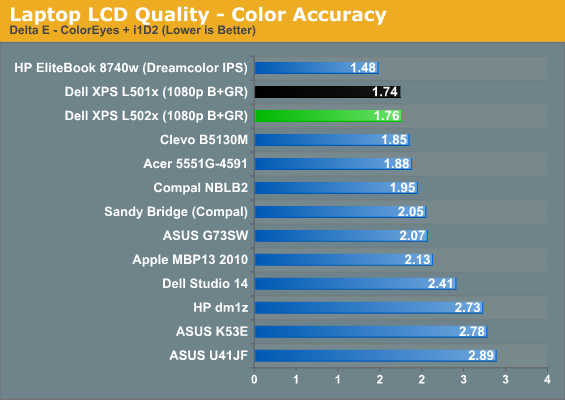
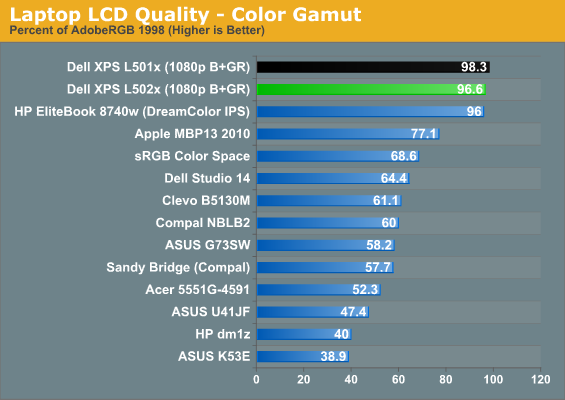
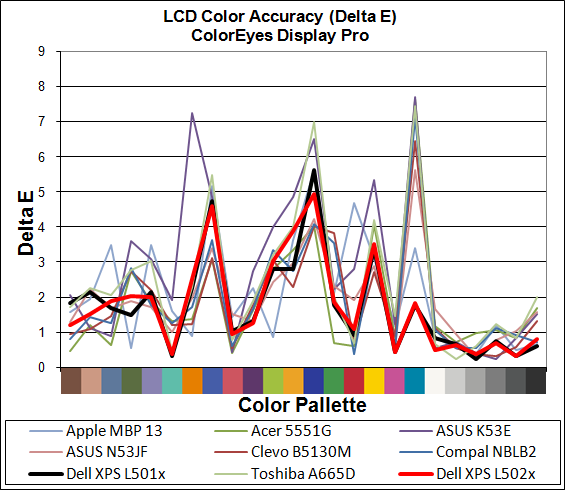
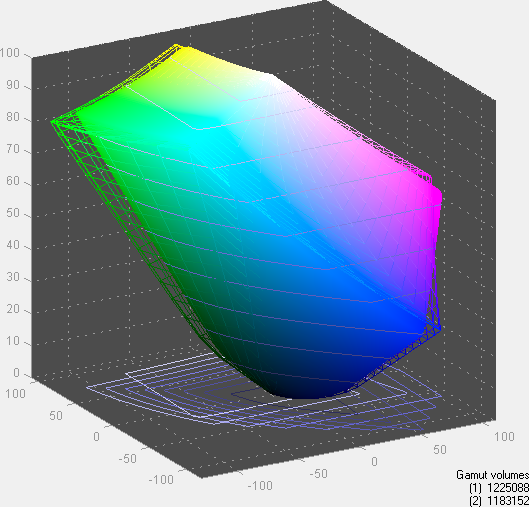
Good contrast, reasonable brightness range, and a great color gamut continue to make this one of the top 15.6” LCDs. We’ve seen the same panel in a few other laptops (including the Compal NBLB2), but there’s still a range of backlight intensity and we’d like to see Dell allow up to 300nits if possible. Actually, what we’d really like to see is an option for a matte coating on the LCD similar to what we’ve seen on the Clevo P150HM. What’s interesting is that the P150HM we tested had a lower color gamut to go with the matte coating, but it also happens to be the same AUO B156HW01 panel. The P150HM was revision v1 and Dell doesn’t indicate which version they’re using, but it’s probably v4. Personally, I’d still be more than willing to give up color gamut for a matte surface.
Heat and Noise Levels
Under sustained loads, the L502x does seem to run hotter than the L501x, but that’s expected. The CPU core temperatures hit 85-91C after several hours of constant 100% load, while the GPU hit a maximum of 80C. Idle noise levels are the same 31dB we measured before, but load noise is also up relative to the L501x. Our SPL showed a noise output of 43.8dB from a distance of 18”, which is audibly louder than the 42dB we hit with the L501x.








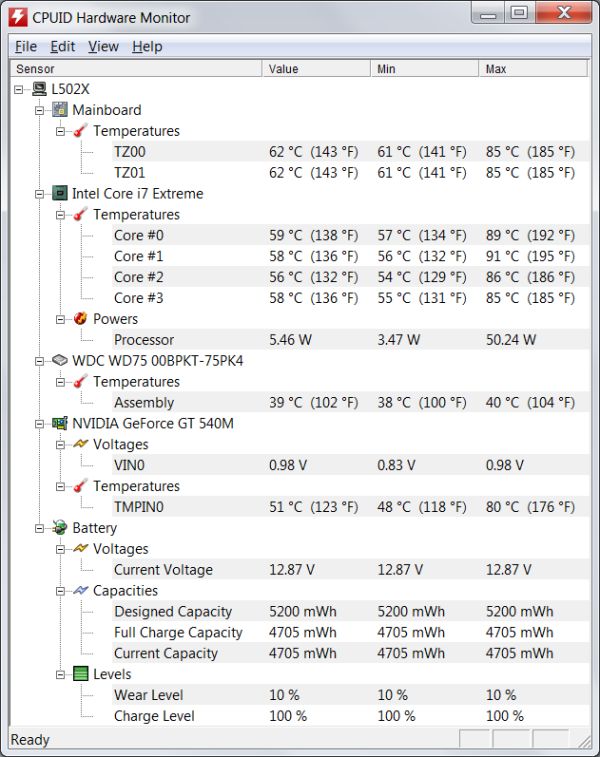








76 Comments
View All Comments
JanusSoCal - Thursday, April 21, 2011 - link
I second everybody who has left comments to say that this is probably the most thorough and detailed review I've read of the XPS 15 so far. But I was curious about three things. First, you didn't mention what you thought of their new island-keyboard design, which I thought was a pretty big change from the 1st gen. Did you find the typing experience and build better with the 1st gen. keyboard or 2nd gen. keyboard? Also, you mentioned that the frame is solid but the top is plastic... I was wondering if that meant the build quality is good or not good, since the frame is supposedly made of magnesium alloy. So, is all that marketing about how the top cover and palm rests are made out of anondized aluminum for a sturdier build is just mere marketing? Is it literally like a very thin coat of aluminum over cheap plastic? And finally, I guess since you gave the Gold Editor's Choice to the 1st Gen XPS 15, did you consider the 2nd Gen XPS 15, against the current crop of laptops more of a silver, bronze, copper?Again, thanks for writing an excellent review, I've been waiting for Anandtech's take on the 2nd gen. XPS 15 for a long time.
JarredWalton - Thursday, April 21, 2011 - link
Ha! I knew something was wrong and I just couldn't put my finger on it, so to speak. I kept thinking, "this doesn't feel as solid as I recall from the first XPS 15," but I figured it was the same. Given the number of laptops I see, sometimes things get a bit fuzzy in my mind so I figured it was still fine. Now that you point it out, the keyboard definitely changed, and IMO it's not for the better. The palm rest on the L502x is also definitely made of plastic, where I believe (but am not certain) the previous model was anodized aluminum. In both cases, the change is a downgrade as far as I'm concerned.I've gone and updated the second page to discuss this a bit more. Ultimately, it's still a good consumer notebook, but it's not without flaws. The previous garnered a Gold by being one of the first laptops in a long time to give us good build quality, a great screen, awesome speakers, and decent all around performance for a moderate price of $1000. The L502x carries forward most of those aspects, but I'd actually downgrade it to a Silver this time around (or an honorable mention without the 1080p LCD upgrade).
will2 - Thursday, April 21, 2011 - link
@jaredwalton. Would appreciate any feedback on my post on above - last post of yesterday, re. if you plan to review the Latitude E6520, and from anyone also, their thoughts on ideal screen size/resolution combinations for photo-editing, film viewing and general business useJarredWalton - Thursday, April 21, 2011 - link
Responded above... sorry I missed it before. :-)will2 - Saturday, April 23, 2011 - link
Many thanks for your views on screen sizes/resolution combinations which seems to support my thinking that after working on a 14" 1440x900 for last 4 years, a change to 15" 1600x900 will maintain my work surface but reduce eye-strain a little.re. "With that in mind, I hope Anandtech can review the SNB Latitude E6520 with 1600x900 screen. Is that likely soon ?" any input on that ?
Re. another posters question, I was thinking the 2520M a good choice of CPU when limited to a 35W TDP series, although I would have preferred a 25W TDP for reduced temperatures, yet giving sufficient performance.
Re. other postings on selection of best SSD, if choosing the Latitude E6520, I was thinking to retain the HDD for data only, and take advantage of new SSD performance by adding a small internal PCIe or ExpressCard SSD to hold and boot the Windows 7 + Apps, as it has no mSATA slot. However, there seem to be few mainstream makers of miniPCIe or ExpressCard SSDs - and those I have seen, at 50 to 100MB/s Sequential Read max, are a long way short of the mSATA Intel 310 200MB/s performance - yet no cheaper ! Do you have any links to good advice on choosing small form factor SSDs for Notebook internal slots ?
Thanks again for your views on screen sizes/resolutions
cookiezulu - Friday, April 22, 2011 - link
I purchased this (LX502) and expected to have it delivered on Tuesday. (1080p, i7-2720, 8GB, 7 Ultimate)I live in the UK so at the time of buying I could only choose the 500 or 750 SATA HDD. I chose the 500 as I thought I was going to replace it with an SSD - I've been convinced by all the reviews here & elsewhere that the difference in speed/performance with an SSD is noticeable. However I'm struggling to decide (from reading the reviews) whether a 256GB Crucial c300 is the best available at the moment for this laptop in the UK. Best in terms of price / performance.
Or should I wait another 2-3 months for some other, greater, better SSD? I've not followed the SSD market in depth so I'm just checking that we're not waiting for some big improvement any day now (and I get caught out buying the c300 now.
Am I right in understanding that even for the same model (C300) the 256GB is faster than the 128GB one?
Also, does anybody know what the SATA controller is in LX502?
Thanks,
Cookie
JarredWalton - Friday, April 22, 2011 - link
The L502x should have both 6Gbps and 3Gbps SATA ports from the HM65 chipset, and presumably the HDD/SSD would use the 6Gbps ports. As such, you can definitely get better performance from the latest 6.0Gbps capable SSDs.The king of the hill right now is the SandForce SF-2200 controller, but the C400 and Intel 510 are both reasonable alternatives. It's really going to come down to pricing. For a 240/256GB SSD, I would probably go for the OCZ Vertex 3. It'll run around $530, give or take, and I have no idea what the UK prices will be, but that's likely the fastest SSD we'll see in the next 8 months.
Regarding size and performance, it depends in part on the process technology for the NAND. 34nm NAND you usually get optimal performance at 120/128GB, and maybe a little bit faster at 240/256GB. When you move to the new 25nm NAND, indications are that the 240/256GB SSDs will be where you start hitting maximum performance (thanks to parallel transfers from the NAND devices/banks). So 120GB Vertex 3 won't be as fast as 240GB, but 480GB will likely be within a few percent of 240GB. Anand discussed this in a recent article: http://www.anandtech.com/show/4256/the-ocz-vertex-...
JarredWalton - Friday, April 22, 2011 - link
Correction: HM67 chipset is what the XPS uses. Also, I have verified that while the system I have is only running the HDD at 300Gbps and the BD-ROM at 150Gbps, both ports are capable of 600Gbps operation (according to SiSoft Sandra).cookiezulu - Sunday, April 24, 2011 - link
Jarred, thanks for your reply. I will wait for my unit to arrive and see what the price for the 240GB Vertex 3 is in a couple of months (currently around £450) and then buy. I was tempted by the more affordable 120GB (around £220) but I'll wait to see what the prices for the bigger one do.Let's hope that when I do swap the HDD for the SSD I don't damage any of the 20 or so clips!
ashegam - Sunday, April 24, 2011 - link
This is has got to be one of the ugliest laptops I've seen in years. This thing looks like it was made in the 90's, wth were they thinking?